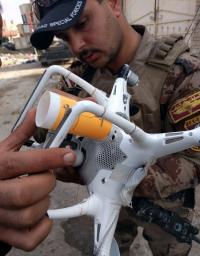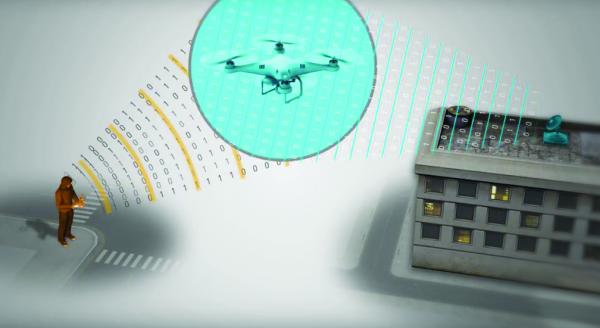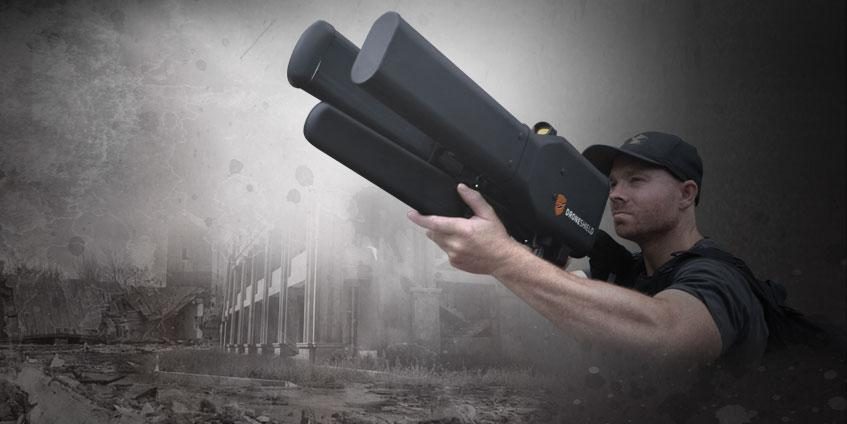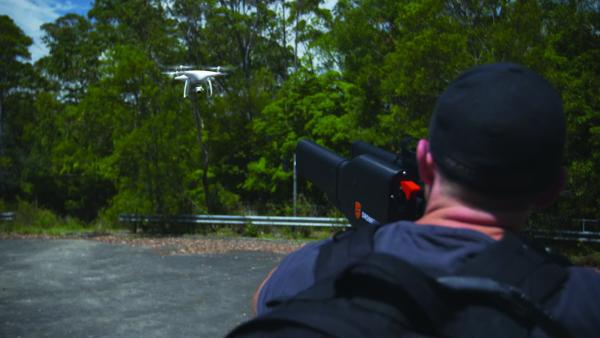Background
Department of Defense (DoD)leadership, academic experts, and industry professionals agree that the threat that unmanned aerial systems (UASs) pose to U.S. military forces is growing and will continue to do so for the foreseeable future. The Pentagon, recognizing this problem, requested that Congress shift $20 million to provide seed money to develop counter-UAS solutions [1, 2]. While some promising technological solutions are emerging [3, 4, 5, 6], the DoD still does not have sufficient deployable counter-UAS solutions, particularly a man-portable system to protect dismounted troops. Although devoting resources toward traditional methods of product development is important, the DoD will continually be playing catch-up until it changes its methods of problem-solving. Investing in programs that promote the collaboration of diverse and nontraditional stakeholders relevant to DoD problems has been, and will continue to be, critical in producing counter-UAS solutions. The DoD must continue to support collaborative efforts if it wishes to get ahead of the next emerging threat.
The Drone Problem
Through the use of UASs, which includes rotary- and fixed-wing drones, nonstate adversaries are now able to threaten U.S. forces with airborne capabilities [7]. According to the Combating Terrorism Center at West Point, drones can be used by adversaries in five ways: (1) for surveillance, (2) for strategic communications, (3) for smuggling or transporting materiel, (4) for disrupting events or complementing other activities, and (5) for use as a weapon [8]. The use of drones for the purposes of surveillance by nonstate actors is well documented [1, 9]. However, the emerging threat of commercial drone weaponization seriously concerns military personnel and government officials.
In recent months, the Islamic State (ISIS) has attempted using various tactics to use drones (such as the one shown in Figure 1) to launch attacks against coalition forces [1], including grenade-dropping drones near Mosul, reportedly deploying 10 explosives during an hour of fighting [10]. Hezbollah has used similar tactics to drop explosives on Syrian rebels [9]. Another tactic, reportedly being used by ISIS in Syria [10], is to strap explosives to a drone and use it as a kamikaze bomber. Lastly, ISIS has used a drone as a decoy improvised explosive device (IED) in what has been dubbed as a Trojan-horse-style attack by embedding explosives inside a drone, which detonated when the downed drone was recovered by coalition forces [11]. Two Kurds were killed, and two French Special Forces operatives were seriously injured in the attack [11]. These instances of UAS weaponiztion, although still relatively rare, have become serious enough that American commanders in Iraq have warned troops to “treat any type of small flying aircraft as a potential explosive device” [1].

Figure 1: Iraqi Counter Terrorism Forces Examine an ISIS Drone Modified to Drop Small Explosives (Photo Courtesy of Mitch Utterback).
Experts predict that the threat from weaponized UASs by nonstate actors will increase “dramatically” in the future [12, 13]. The Combating Terrorism Center at West Point identifies three drivers that will likely increase the frequency and effectiveness of weaponized drone use in the future: (1) the expected proliferation of drones and enhancement of capabilities, including increased payload capacity, flight time, and communications security; (2) the increased connectivity between actors, resulting in derivative weaponization attempts; and (3) the accessibility and distance provided by UASs that allow for actors with marginal interests and motivation to engage in kinetic attacks from afar [8]. Given these drivers, U.S. forces can expect an increase in weaponized UAS attacks in the future. The question remains, however, as to whether U.S. forces will be able to defend against this rapidly evolving threat.
Technical Solutions
Given the attention and resources being devoted to the UAS threat by the DoD, it is not surprising that some promising technologies have emerged. DroneShield, for example, produces a sensor network with “acoustic detection technology” that can sense a drone invisible to radar and lacking radio frequency links by analyzing its acoustic signature and comparing the sample to a database. If the observed acoustic signature matches a signature in the database, the system issues an alert to the user. Then, using DroneShield’s DroneGun (pictured in Figure 2), a user is able to “jam” drones, purportedly within a 2-km range and in a variety of environmental conditions [4].
Another promising technology, MESMER, developed by Department 13, also detects and identifies drones. However, MESMER does not kinetically attack or jam drones. Rather, it employs a low-power and low-interference strategy called “protocol manipulation,” whereby MESMER sends signals to a drone that persuade it to listen to a new control system other than the pilot (as illustrated in Figure 3). After the drone is “mesmerized” by the new signal, the threat can be mitigated by forcing the drone to land in place or in a predesignated area [5].

Many other potential technical solutions exist, as evidenced by the 50 counter-UAS systems tested at the DoD’s Black Dart event [9]. However, counter-UAS systems continue to face a variety of problems. For example, “jamming,” as is done by DroneGun, can be highly problematic. If a UAS is carrying an explosive payload over a populated environment, disabling the drone might prevent it from reaching its intended target, but at the risk of potentially injuring civilians beneath the drone. Another problem with DroneGun is that it consists of a large rifle attachment and a backpack. While DroneShield touts its product as “portable,” it requires troops to add a significant amount of weight to the modern-day soldier’s already heavy load, which can limit maneuverability and increase risk of injury [14]. In addition, both DroneShield and MESMER require large, stationary sensing hardware, eliminating the possibility that either solution could be employed by dismounted troops in forward operating environments.
According to the Asymmetric Warfare Group (AWG), given the number of issues identified with the promising technologies previously identified, it is understandable that the UAS threat to DoD personnel and equipment is still considered “absolutely pressing,” despite the prevalence of potential counter-UAS solutions.
The Collaboration Imperative
The DoD has recognized that success in its counter-UAS mission will require successful integration of numerous capabilities across several domains [15]. While it is clear that investing time and resources in developing counter-UAS capabilities needs to continue, what may be less clear (but arguably more important) is that the DoD needs new methods of developing solutions. When facing a threat that is evolving as rapidly as the UAS threat, the DoD needs to engage with nontraditional stakeholders in ways outside of the normal development and acquisition process. This necessity is the Collaboration Imperative.
The DoD has made efforts to this end, especially when it comes to intragovernmental collaboration. In the fall of 2016, the DoD held a counter-drone exercise called Black Dart, which tested technologies for detecting, identifying, tracking, and defeating UASs. Black Dart featured more than 20 variants of UASs, more than 50 counter-UASs, and some 25 government entities, including the Department of Homeland Security and the Federal Aviation Administration, and numerous organizations from academia and industry [9].
While an interagency approach can be a productive problem-solving method, the Combating Terrorism Center at West Point justly questions whether internal efforts such as Black Dart are “forward-leaning enough” [8]. The West Point report concludes by prescribing that the government remain open minded and equally creative about the government and nongovernment structures it creates to facilitate the meaningful exchange of ideas and the people it brings in to serve as advisers [8]. The structures and methods identified by the West Point report have been formalized into a concept called the Defense Innovation Base, developed by Adam Jay Harrison, Director of the MD5 National Security Technology Accelerator.
The Defense Innovation Base would include, “a more diverse, independent, and unencumbered set of participants,” including commercial firms, academic institutions, and private citizens, to improve the capacity of the DoD to adapt to disruption [16]. Thus, the base would not only bring new and diverse individuals into the problem-framing and -solving process, but it would also improve the speed at which the DoD reacts to “an uncertain, rapidly evolving world subject to disruptions that cannot be predicted or planned for with a high level of certainty” [16].
The creation of a Defense Innovation Base can be accomplished through a variety of rapid, iterative development events, ranging from “hackathons” (collaborative problem-solving sprint events involving participants with diverse backgrounds) and challenges to educational classes. While the particular details of these events are not necessarily important, the critical variable is that any such programming must leverage the diversity of stakeholders, inside and outside of government, that come together to participate in any given event. To its credit, the DoD has begun to engage in some collaborative programming, albeit at a limited scale. Nonetheless, the successes of two programs relevant to the UAS threat, outlined in following text, deserve mention.
#HackTheSky
In the summer of 2016, the Naval Postgraduate School (NPS) held a hackathon called #HackTheSky to better understand how to hack into the code controlling autonomous swarming drones. The event brought together cyber experts, data scientists, Silicon Valley tech representatives, and other hackers, representing more than 70 organizations, most of which had never before worked with the government. At the end of the event, Cmdr. Zachary Staples, Director of the NPS Center for Cyber Warfare, stated, “The event proved to achieve all we had hoped it would—improved control software and several steps forward on some innovative technology developed on a shoestring budget” [17]. Hackathons such as #HackTheSky and others hosted by the MD5 National Security Technology Accelerator in New York, NY, and Austin, TX, are promising examples of efforts to address the Collaboration Imperative [18].
Hacking for Defense (H4D)
H4D, a university-sponsored class that pairs real DoD problems with student teams who, through stakeholder interviews, conceive and discuss potential solutions, is another promising example of the DoD leveraging nontraditional innovators. Piloted at Stanford University in the spring of 2016, H4D has since expanded to four universities, including Georgetown. At Georgetown, the AWG has charged one team of students with creating a man-portable solution to detect, identify, and neutralize UASs [19]. As described in the next section, this team, called H4Drone, is already discovering information through stakeholder interviews relevant to the UAS problem that would not have been discovered by internal innovation processes. At the end of the class, this team, along with the other teams, will present their solutions to representatives of the corresponding governmental agency. And (as was the case with the inaugural Stanford class) a number of these solutions will likely either be implemented internally or receive funding for further development [20].
Why Collaboration Works
Collaborative programming and efforts such as #HackTheSky and H4D work for three reasons: (1) the diversity of participants involved, (2) the ability of diverse participants to identify the specific needs of individuals and agencies, and (3) the speed at which the participants can make progress toward deploying solutions.
Diversity of Participants
The benefits of diversity of thought as a result of diversity of participation is built into events such as hackathons and classes such as H4D. For example, Cmdr. Staples noted that the NPS Hackathon was designed to increase the diversity of the Navy’s technological base because the Navy recognizes that, “diverse teams address and solve problems with greater flexibility and creativity” [17]. Similarly, H4D leverages the diverse perspective of university students compared to internal DoD personnel. The AWG, which sponsored H4Drone’s counter-UAS problem, noted that AWG submits real government problems to the course because it appreciates fresh perspective and values student input. According to Mr. Alex Kravets, a master’s degree candidate at the Georgetown School of Foreign Service and a team member of H4Drone, “military folks are really good at certain things, but creative thinking and thinking about commercial solutions is a little foreign to them.” Thus, by enlisting the perspective of stakeholders outside of government, collaborative programming leverages diverse expertise toward internal DoD problems that would otherwise not be used.
Product Fit
Given the diversity of needs across DoD organizations, it is no surprise that one solution does not fit all applications, for the UAS threat and beyond. For example, MESMER might be appropriate for defending military infrastructure but would not satisfy the man-portable requirement specified by AWG’s problem statement. Collaborative programming, however, allows participants to get a better understanding of the problem space, including agency constraints and requirements, and potential solutions. Mr. Michael McGruddy, another master’s degree candidate at the Georgetown School of Foreign Service and H4Drone team member, found through the H4D customer discovery process that “each agency and service sees the problem differently according to their own needs.” He also noted that the process enables participants to get a perspective that few others are able to achieve, even experts in the field.” Similarly, hackathons, when properly designed, bring together the DoD and military personnel who experience a given threat on a daily basis with nontraditional problem-solvers, who can gain an in-depth understanding of the problem through a similar interview process. Therefore, collaborative programs not only bring more ideas and perspectives to the table, but they also allow for the synthesizing of ideas and perspectives to create a better understanding of the problem space and potential solutions relevant to specific end users or beneficiaries.
Speed
The speed of product development and deployment of new technology is critical to its effectiveness in modern military operations. Experts predict a series of “action-reaction-counter-reactions” between coalition forces and adversaries in the UAS fight, as occurred with the roadside IED threat in Iraq and Afghanistan [7]. Traditional development and acquisition processes are too slow to adapt to the pace of change in the modern battlefield environment. In the context of the UAS threat, Mr. Kravets notes, “The technology is advancing incredibly rapidly. A solution that might work for countering drones 6 months out most likely won’t be effective 12–18 months out.” Collaborative problem-solving, however, allows for solutions to be solved at speed. Although no complete solution can likely be developed at a hackathon or H4D course, hackathon participants work long hours over multiple days to produce partial solutions and often make significant progress, as was the case at the NPS Hackathon [17]. H4D is also conducted at an incredibly fast pace. As such, collaborative problem-framing and -solving produce a concentration of focus and effort that can significantly contribute toward progress on a given problem in ways that are not always possible through traditional methods of product development.
Conclusion
Technology is the battlefield of today and tomorrow. And to “own the high ground” on that battleground, the U.S. military must master the tactics of innovation [16]. Given the pace of technological innovation and the increasing number of adversaries able to innovate at low cost, traditional DoD development and acquisition are insufficient, as evidenced by the UAS threat and response. As the Combating Terrorism Center at West Point argues, our ability to prevent weaponized drone attacks is only as good as our ability to think in creative ways [8]. And creative thinking, produced by the collaboration of diverse stakeholders in nontraditional environments, must be a priority if the DoD wants to mitigate emerging threats. Such is the Collaboration Imperative.
References:
- Schmidt, M. S., and E. Schmitt. “Pentagon Confronts a New Threat from ISIS: Exploding Drones.” New York Times, https://www.nytimes.com/2016/10/12/world/middleeast/iraq-drones-isis.html?_r=0. 11 October 2016.
- Capaccio, A. “Armed Drones Used by Islamic State Posing New Threat in Iraq.” Bloomberg, https://www.bloomberg.com/news/articles/2016-07-07/armed-drones-used-by-islamic-state-posing-new-threat-in-iraq, 7 July 2016.
- Tarantola, A. “The SkyWall 100 Is a Net-Launching Anti-Drone Bazooka.” Engadget, https://www.engadget.com/2016/03/03/the-skywall-100-is-a-net-launching-anti-drone-bazooka/, 3 March 2016.
- DroneShield. “How DroneShield Works.” https://www.droneshield.com/how-droneshield-works, accessed January 2017.
- Department 13 International. “Mesmer Counter Drone Solution.” https://department13.com/mesmer/#1490801854762-2bb33e42-1ba8, accessed January 2017.
- U.S. Army Aviation and Missile Research, Development and Engineering Center. “Army Technologies Participate in Counter- UAS Demonstration.” Army.mil, https://www.army.mil/article/176509/army_technologies_participate_in_counter_uas_demonstration, 11 October 2016.
- Franke, U. “Flying IEDs: The Next Big Threat.” https://warontherocks.com/2016/10/flying-ieds-the-next-big-threat/, 13 October 2016.
- Rassler, D. “Remotely Piloted Innovation: Terrorism, Drones and Supportive Technology.” Combating Terrorism Center, U.S. Military Academy, https://www.ctc.usma.edu/v2/wp-content/uploads/2016/10/Drones-Report.pdf, 2016.
- Whittle, R. “Counter-Drone Exercise Black Dart Expands, Moves to Eglin AFB.” http://breakingdefense.com/2016/09/counter-drone-exercise-black-dart-expands-moves-to-eglin-afb/, 2 September 2016.
- Watson, B. “The Drones of ISIS.” http://www.defenseone.com/technology/2017/01/drones-isis/134542/, 12 January 2017.
- Salama, V., and L. C. Baldor. “Drone Attack on Kurd-ish, French Forces Reveals New Threats.” http://www.militarytimes.com/articles/isis-weaponizes-drones-us-official-confirms, 12 October 2016.
- Jacobsen, M. “Why the Flying IED Threat Has Barely Started.” https://warontherocks.com/2016/10/why-the-flying-ied-threat-has-barely-started/, 19 October 2016.
- Sayler, K. “A World of Proliferated Drones: A Technology Primer.” Center for a New American Security, http://drones.cnas.org/wp-content/uploads/2016/03/CNAS-World-of-Drones_052115.pdf, 2015.
- Ripley, A. “Lightening the Load for the Modern Marine.” DSIAC Journal, vol. 3, no. 1, pp. 31–34, accessed https://www.dsiac.org/resources/journals/dsiac/winter-2016-volume-3-number-1/lightening-load-modern-marine, 2016.
- “United States Army Counter – Unmanned Aircraft System (C-UAS) Strategy Extract.” Retrieved from http://www.arcic.army.mil/App_Documents/Army-CUAS-Strategy.pdf, 5 October 2016.
- Harrison, A. J., J. Rachami, and C. Zember. “Technology Domain Awareness: Building the Defense Innovation Base.” Georgetown Security Studies Review, vol. 3, no. 1, pp. 32–46, http://georgetownsecuritystudiesreview.org/wp-content/uploads/2015/02/GSSR-Vol.-3-Iss.-1.pdf, 2015.
- Staples, Z. “Navy Innovation, Silicon Valley Style.” CHIPS, http://www.doncio.navy.mil/CHIPS/ArticleDetails.aspx?ID=8025, July 2016.
- MD5. “About MD5.” https://www.md5.net/about, accessed February 2017.
- Georgetown University. “DOD/IC Challenges.” Walsh School of Foreign Service, Security Studies Program, http://www.hacking4defensegu.com/dodic-challenges/#dodic-challenges-1, February 2017.
- Yoon, S. “Stanford Class Challenges Students to Pick Defense Over Google.” https://www.bloomberg.com/news/articles/2016-11-30/stanford-class-challenges-students-to-pick-defense-over-google, 30 November 2016.



